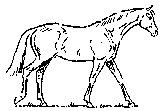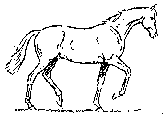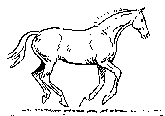Tracy Goodbrand and Steeldust

| Articles |
| Gaits of a Horse |
| Glossary |
| Humor |
| Parts of a Horse |
| Quotes |
| Vital Signs |
Gaits of a Horse
The average (ungaited) horse has three (3) gaits: a walk, a trot (jog), and a canter (lope).
Below is an explanation of each gait as well as an animation of the gait
The horse at the walk: A walk is a four (4) beat. This means that each leg touches the ground one at a time. |
 |
|
The horse at the trot: A trot is a two (2) beat, and is a diagonal movement. For example, the left front and the right hind leg touch the ground at the same time, for one (1) beat, then the right front and left hind leg touch the ground at the same time, for the second (2nd) beat. |
 |
|
The horse at the canter (lope): A canter (lope) is a three (3) beat. First Beat: The right hind touches the ground Notice in the picture how the left hind leg and the left front leg are "leading" or are in front of the right legs. That is what determines the left lead. The right lead is when the right hind leg and the right front leg are "leading" the left legs. Notes: A canter and a lope are the same gaits. A canter is the english riding term while a lope is the western riding term |
 |
|